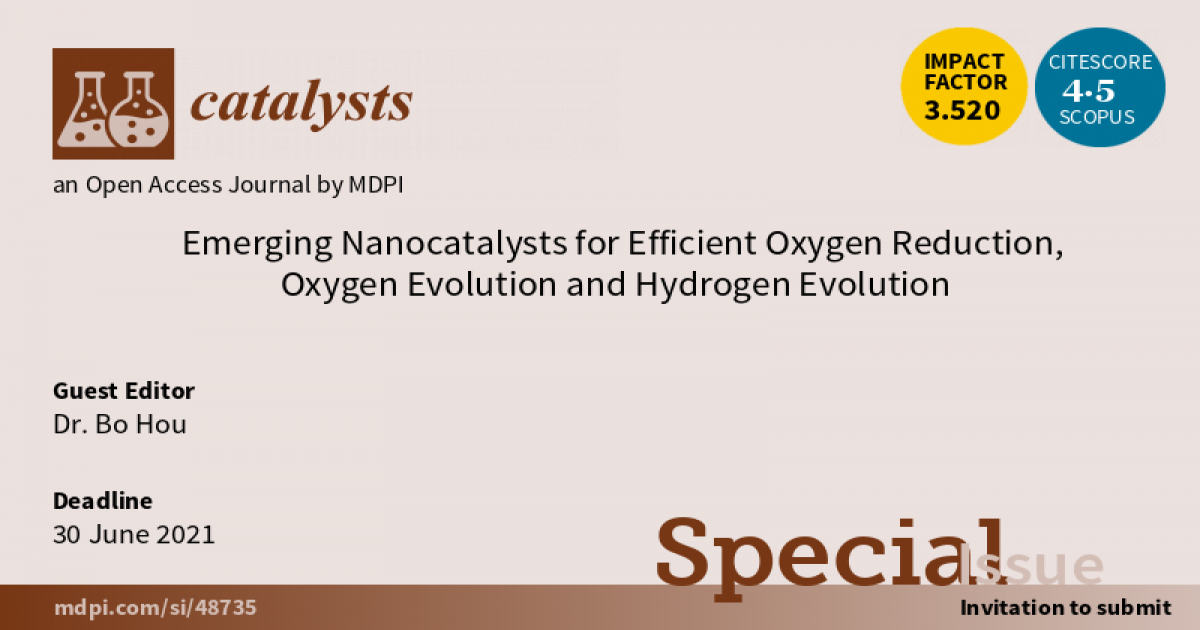Emerging Nanocatalysts for Efficient Oxygen Reduction, Oxygen Evolution and Hydrogen Evolution
A special issue of Catalysts (ISSN 2073-4344). This special issue belongs to the section "Nanostructured Catalysts".
Deadline for manuscript submissions: closed (30 June 2021) | Viewed by 66277

Special Issue Editor
Interests: quantum dot synthesis; quantum dot optoelectronics (PV, LED, photodetector, display and image sensors); electron microscopy (TEM) and dynamic charge transfer analysis
Special Issues, Collections and Topics in MDPI journals
Special Issue Information
Dear Colleagues,
The problem of global warming and global climate change cannot be ignored in any discussion regarding long-term environment policy—and the solution, as part of a comprehensive sustainable energy plan, is reducing or stopping greenhouse gas emissions which are generated through the release of naturally sequestered carbon via the human practice of burning fossil fuels. The ever-increasing detrimental effects of traditional fuels on the environment have stimulated extensive efforts worldwide to develop green and renewable energy technologies, including fuel cells, metal-air batteries and water-splitting systems. The fundamental electrochemical reaction mechanisms behind these renewable energy technologies are oxygen reduction reaction (ORR), oxygen evolution reaction (OER) and hydrogen evolution reaction (HER). Indeed, the ORR is the heart of fuel cells, while the OER and HER are of paramount importance to metal-air batteries and electrochemical water-splitting systems. However, the large intrinsic overpotential associated with sluggish OER on anode and HER on the cathode make these electrochemical reactions inefficient. Thus, it is imperative to develop highly active catalysts to reduce the overpotential dramatically. So far, numerous promising nanocatalysts have been demonstrated, including i) multimetal oxide compound nanomaterials such as layered hydroxide, spinel and amorphous metal oxides; ii) metal-free nanocatalysts such as carbon nanotubes (CNTs), graphene, graphite, carbon nitride and 3D carbon architectures; iii) metallic transition–metal dichalcogenide (TMDC) nanocatalysts, where M represents a transition metal atom typically from group IVB to VIIB in the periodic table and X is a chalcogen atom such as S, Se, or Te; iv) Perovskite oxides (POs) such as ABO3±δ (where, A is alkaline or rare earth cations, B is first- row transition metal cations and δ is oxygen non-stoichiometry), Ruddlesden–Popper (An+ 1BnO3n + 1), Dion–Jacobson (AnBnO3n + 1), Aurivillius (Bi2An-1BnO3n + 3) homologous series, double- (A2BB’O6) and triple- (A2A’B2B’O9) layered POs, etc.
This Special Issue will focus on experimental and theoretical investigations into new nanocatalysts for the ORR, OER and HER, with a particular interest in the noble-metal-free or metal-free nanomaterials. Fundamental, applied studies, theoretical studies and advanced characterizations (structure, morphology, or interface charge transfer) are of interest. Additionally relevant are reports that detail new nanocatalysts for photoelectrolysis for water splitting, photocathodic protection and electrochemical organic degradation. The hope is to compile a set of manuscripts that inform the field of the state-of-the-art in electrochemical nanocatalysis.
Dr. Bo Hou
Guest Editor
Manuscript Submission Information
Manuscripts should be submitted online at www.mdpi.com by registering and logging in to this website. Once you are registered, click here to go to the submission form. Manuscripts can be submitted until the deadline. All submissions that pass pre-check are peer-reviewed. Accepted papers will be published continuously in the journal (as soon as accepted) and will be listed together on the special issue website. Research articles, review articles as well as short communications are invited. For planned papers, a title and short abstract (about 250 words) can be sent to the Editorial Office for assessment.
Submitted manuscripts should not have been published previously, nor be under consideration for publication elsewhere (except conference proceedings papers). All manuscripts are thoroughly refereed through a single-blind peer-review process. A guide for authors and other relevant information for submission of manuscripts is available on the Instructions for Authors page. Catalysts is an international peer-reviewed open access monthly journal published by MDPI.
Please visit the Instructions for Authors page before submitting a manuscript. The Article Processing Charge (APC) for publication in this open access journal is 2200 CHF (Swiss Francs). Submitted papers should be well formatted and use good English. Authors may use MDPI's English editing service prior to publication or during author revisions.
Keywords
- oxygen reduction reaction (ORR)
- oxygen evolution reaction (OER)
- hydrogen evolution reaction (HER)
- bifunctional electrocatalyst
- metal-air batteries
- water splitting
- carbon materials
- perovskite oxide
- photocathodic protection
- electrochemical organic degradation
- electrochemical supercapacitor
- fuel cells
- solar fuels
- photoelectrolysis
- density functional theory
- molecular dynamics
- electron microscopy
- electrochemical impedance spectroscopy
Benefits of Publishing in a Special Issue
- Ease of navigation: Grouping papers by topic helps scholars navigate broad scope journals more efficiently.
- Greater discoverability: Special Issues support the reach and impact of scientific research. Articles in Special Issues are more discoverable and cited more frequently.
- Expansion of research network: Special Issues facilitate connections among authors, fostering scientific collaborations.
- External promotion: Articles in Special Issues are often promoted through the journal's social media, increasing their visibility.
- Reprint: MDPI Books provides the opportunity to republish successful Special Issues in book format, both online and in print.
Further information on MDPI's Special Issue policies can be found here.





